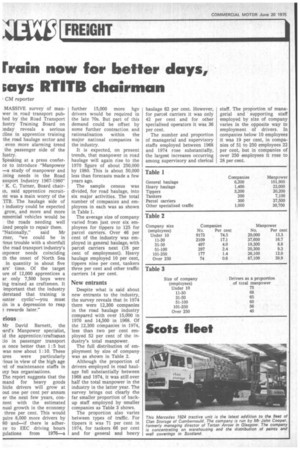Train now for better days, says RTITB chairman
Page 44

If you've noticed an error in this article please click here to report it so we can fix it.
CM reporter MASSIVE survey of manwer in road • transport pubhed by the Road Transport lustry Training Board on mday reveals a serious cline in apprentice training the road haulage sector and even more alarming trend the passenger side of the lustry.
Speaking at a press conferee to introduce ."Manpower —a study of manpower and ,ining needs in the Road ansport Industry 1967-1980" • K. C. Turner, Board chairin, said apprentice recruitmt was a main worry of the 7ITB. The haulage side of industry could be expected grow, and more and more mmercial vehicles would be the roads needing well ined people to repair them, "Nationally," said Mr rner, "we could be in itous trouble with a shortfall the road transport industry's tnpower needs coinciding th the onset of North Sea in quantity in about five ars' time. Of the target ure of 12,000 apprentices a ar only 7,500 boys were ing trained as craftsmen. It important that the industry derstand that training is lunter cyclic'—you must tin in a depression to reap rewards later."
rious
Mr David Barnett, the rard's Manpower specialist, id the apprentice/craftsman t.io in passenger transport is once better than 1:5 but was now about 1:10. These ures were particularly 7ious in view of the high age rel of maintenance staffs in my bus organisations.
The report 'suggests that the mand for heavy goods hide drivers will grow at out one per cent per annum er the next few years, content with the estimated nual growth in the economy three per cent. This would wire 8,000 more drivers by SO and—if there is adherce to EEC driving hours gulations from 1976—a further 15,000 more hgv drivers would be required in the late 70s. But part of this demand could be offset by some further contraction •and rationalisation within the major national companies in the industry.
It is expected, on present trends, that manpower in road haulage will again rise to the 1970 figure of about 250,000 by 1980. This is about 50,000 less than forecasts made a few years ago.
The sample census was divided, for road haulage, into six major activities. The total number of companies and employees in each was as shown in Table 1.
The average size of company varied from just over six employees for tippers to 125 for parcel carriers. Over 46 per cent of the industry was employed in general haulage, with parcel carriers next (IS per cent of employment). Heavy haulage employed 10 per cent, tippers nine per rent, tankers three per cent and other traffic carriers 14 per cent.
New entrants
Despite what is said about new entrants to the industry, the survey reveals that in 1974 there were 12,300 companies in the road haulage industry compared with over 15,000 in 1970 and 14,500 in 1968. Of the 12,300 companies in 1974, less than two per cent employed 52 per cent of the industry's total manpower.
The full distribution of employment by size of company was as shown in Table 2.
Although the proportion of drivers employed in road haulage fell substantially between 1968 and 1974, it was still over half the total manpower in the industry in the latter year. The survey brings out clearly the far smaller proportion of backup staff employed by smaller companies as Table 3 shows. .
The proportion also varies between types of traffic. For tippers it was 71 per cent in 1974, for tankers 66 per cent and for general and heavy haulage 62 per cent. However, for parcel carriers it was only 42 per cent and for other specialised operators it was 36 per cent.
The number and proportion of managerial and supervisory staffs employed between 1968 and 1974 rose substantially, the largest increases occurring among supervisory and clerical staff. The proportion of managerial and supporting staff employed by size of company varies in the opposite way to employment of drivers. In companies below 10 employees it was 19 per cent, in companies of 51 to 250 employees 22 per cent, but in companies of over 250 employees it rose to 28 per cent.




























































































































































